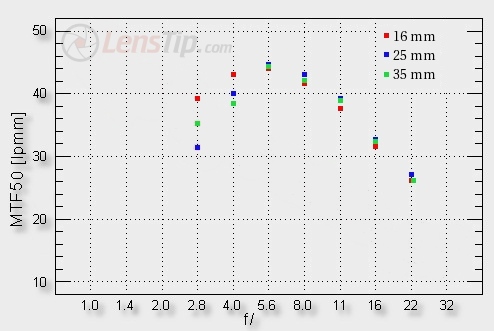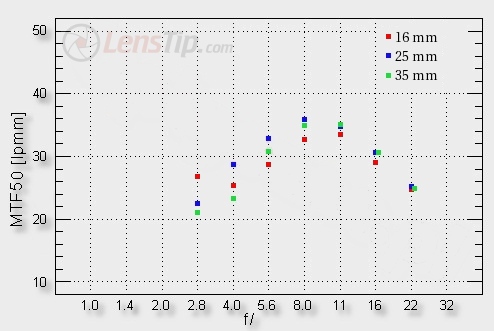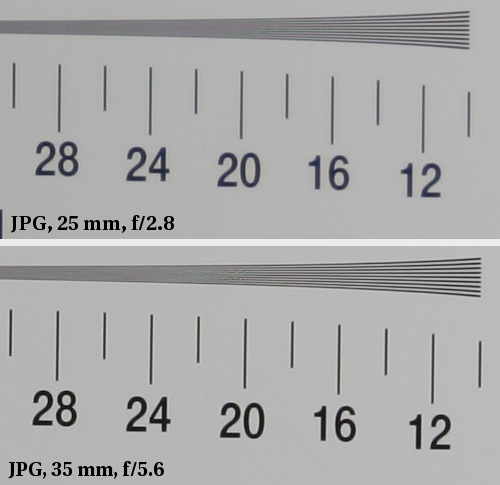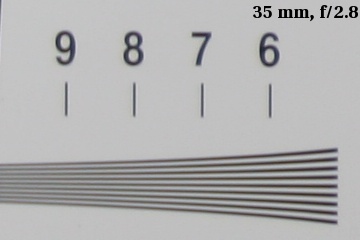Canon EF 16-35 mm f/2.8L II USM
4. Image resolution

Firstly, the maximum results are indeed close to records. By f/5.6 at all focal lengths the lens reaches ideally even and outstandingly high level of 44 lpmm. When the maximum aperture is increased to f/4.0 we will start to notice differences between particular focal lengths but still the level will remain very high. By f/2.8 the differences between particular focal lengths are the biggest. You can have no reservations about the 16 mm performance because there the lens reaches almost 40 lpmm. At 35 mm the situation is not bad either because the level of 35 lpmm, when wide open, you can accept as very good without a problem. The worst result, but still relatively high, we get for the middle of the focal lengths range – we barely pass 30 lpmm there.
Please Support UsIf you enjoy our reviews and articles, and you want us to continue our work please, support our website by donating through PayPal. The funds are going to be used for paying our editorial team, renting servers, and equipping our testing studio; only that way we will be able to continue providing you interesting content for free. |
- - - - - - - - - - - - - - - - - - - - - - - - - - - - - - - - - - - - - - - - - - - - - - - -
If the frame centre performance deserves only praise, we were very disappointed looking at the results for the frame edge. The MTF values in the graph below speak for themselves.

First of all, to reach the decency level, situated for high class lenses at 30 lpmm, we have to stop down by two f stops! At the maximum aperture and by longer focal lengths this lens, after all designed for full frame, barely exceeds the level of 20 lpmm and we speak about a performance on a small APS-C matrix! A huge slip-up if I’ve ever seen one!
The results are one thing, though; it’s always worth taking a reality check. First, let’s have a look at the JPEG files of our test charts. Two frame centre crops are presented at the beginning, showing the weakest (25 mm, f/2.8) and the best (35 mm, f/5.6) results.

Below, a frame corner crop for f2.8 and 35 mm focal length. As you see, there’s really nothing to be happy about.

Especially that in normal pictures where the elements can be positioned a bit differently than in our charts, the situation can be even more complicated. Please, look closely at the sample shot nr 10, presented in the last chapter, which was made using the 16 mm focal length and f/4.5 aperture (at which the frame edge reaches a mysterious, but visible independently on all charts, local resolution minimum). These parameters guarantee that the figure, photographed from about 3 meters, should be all in the depth of field range. Meanwhile we can see that the figure’s platform is ideally sharp but its face – clearly blurred.
As we had in our office a Canon 1D Mark III during the test, we could at least check on sample photos how the lens performs at the frame edge of an APS-H sensor (multiplier 1.3x). Here the picture nr 13 is especially helpful, as it was taken using the 16 mm focal length and the f/4.0 aperture. The frame edges don’t look encouraging at all. Yes, I know…it’s the case when for the two hundred and thirty seventh time we happened to come across a faulty copy.
The faulty copy hypothesis is contradicted by pictures taken with a lens presented at its launch conference. Let’s just remind here that we had an opportunity to take several photos with a different copy of the tested L-series lens and we didn’t like the results, coming from a 20D as well as from a 40D. We didn’t comment the whole issue then as, not having a support in the form of our test chart results, we didn’t want to create a storm. However, you can form an opinion about the lens’s frame edge performance on your own by looking at the sample shot, published in the report and took at 16 mm and f/5.0. The direct link to the shot you can find here. Please, pay close attention to the hair of the model on the left or to the white printer, positioned on the right. We still are dealing here with a small 20D sensor and the f/5.0 aperture after all.






